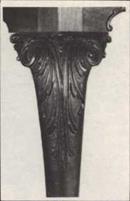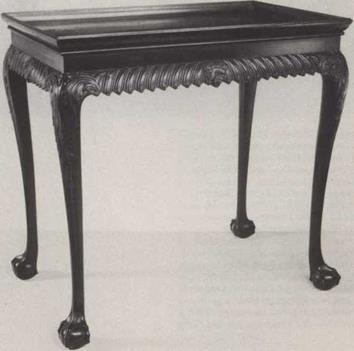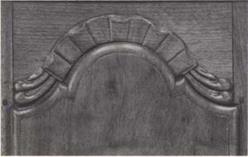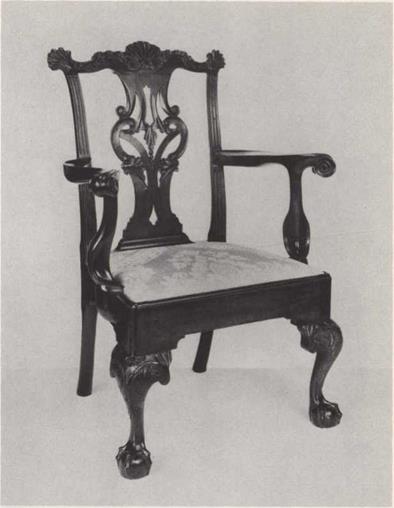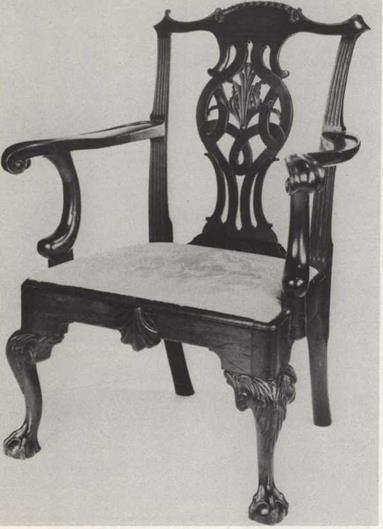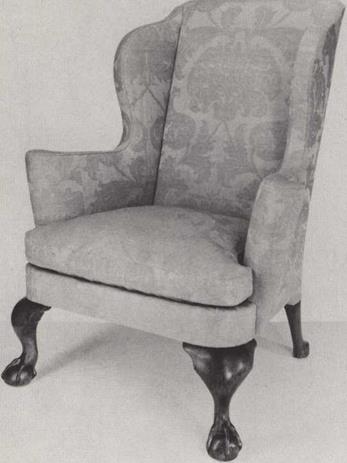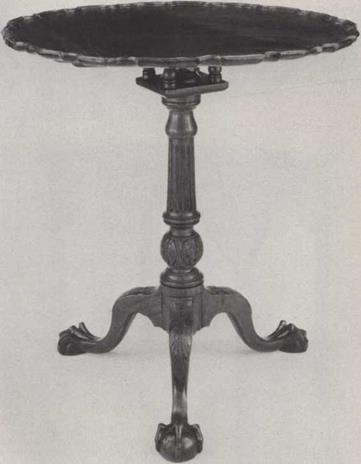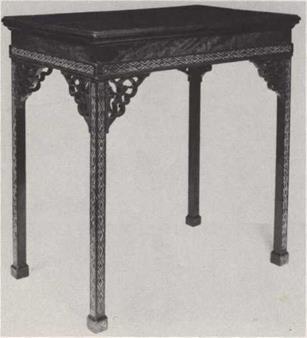|
|
Figures 104 and 105. Card Tables. Wealth, skilled competitors, population growth, and knowledge of fashion were parts of a mixture of ingredients in Philadelphia that produced imaginative variety in furniture design. A straight frame with nonconforming top supported by tapered Marlborough legs provides a contrasting form in Figure 105. Top corners are rounded, like those seen on Philadelphia breakfast tables (Figs.
97-98). A scrolled leaf and cabochon carved shaped skirt (Fig. 104) contrasts with applied gadrooning and pierced C-scroll brackets (Fig. 105).
Fig. 104: mahogany, white cedar, white oak;
1765-80; W 34 " (86.3 cm); acc. no. G60.1059. Fig.
105: mahogany, white oak, yellow pine, tulip; 177585; W 36" (91.4 cm); acc. no. C52.258.
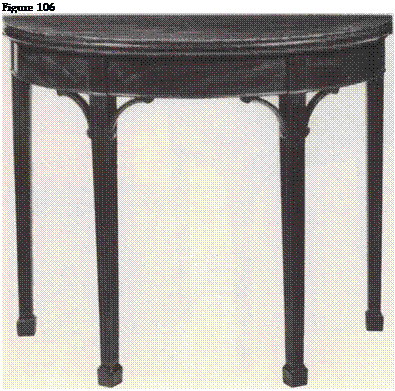
Figure 106. Card Table. Shortly before the Revolution, the new classical style of the Adam brothers began to affect furniture design. In 1773, in a list of books to be purchased for the Library Company of Philadelphia, was "The Works in Architecture of Robert and James Adam… (as far as now Publish’dJ."55 This circular card table, with fluted, tapered Marlborough legs, blocklike spade feet, and C-scroll brackets is believed to be the work of Jonathan Costelowe (w. 1768-93). When Gostelowe advertised in 1793 that he was declining the business of cabinetmaking, his notice included an offer to sell circular card tables.56 Fig. 106: mahogany, white oak, yellow pine, tulip; 1785-93; W 36’U" (92.1 cm); acc. no. 58.46.6.
|
Figure 107. Dressing Table. Popularly called a lowboy, during the Chippendale period this form was referred to as a dressing, or chamber, table. At his death in 1776, William Logan had 6 chamber tables "with drawers” made of mahogany, walnut, or maple.57 This table’s shaped front skirt, double arched side skirt, fluted chamfered corners, and large but subdued shell-carved drawer front are considered to be features of Maryland Chippendale furniture.5S But the pages of Hornor’s Blue Book contain illustrations of dressing tables similar to Figure 107 that were owned by Philadelphia families. Fig. 107: walnut, tulip; 1760-80; W 34V (88.7 cm); acc. no. G53.68. |
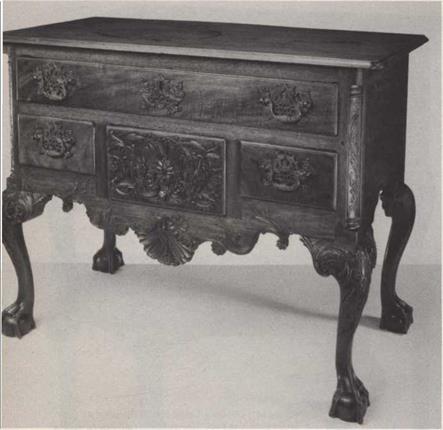
Figure 108. Dressing Table. Figure 108 is the "Table to Suit" the high chest of drawers made in 1769 for Michael and Miriam Cratz of Philadelphia (PI. XI). Whether of mahogany, walnut, or maple, the form always consists of a long drawer over three smaller ones. Despite the abundance of rich carving—ribboned leaves, ruffles, flowers, cabochon, balanced and asymmetrical shells— enough of its mahogany surface has been left undecorated to provide contrast. Fig. 108: mahogany, white cedar, tulip; 1769; W 37" (94 cm); top is an old replacement; асе. no. C57.505.
Figure 109. Bureau Dressing Table.
This form was known throughout the 18th century as a bureau table, and was most popular in Philadelphia,59 Price lists for that city indicate that a mahogany bureau table with prospect door and quarter columns (as Fig. 109) cost 8 pounds, 10 shillings. A plain design for a bureau dressing table, with 3 drawers on each side of a prospect door, and ogee bracket feet appears only in the 1754 edition of the Director. Fig. 109: walnut, yellow pine; 1755-75; И/ 39V (100.9 cm); gift of Mr. and Mrs. David Stockwell; асе. no. C66.138.
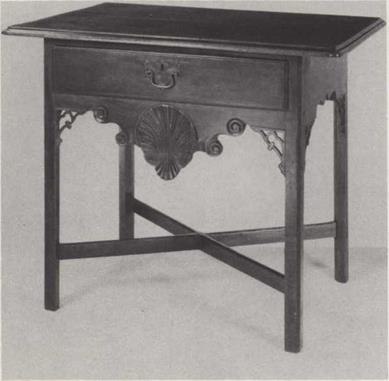 |
Figure 110. Dressing or Side Table. It is tempting to relate Figure 110 to furniture made in Lancaster County, Penn. (Figs. 87, 94), but it was probably made in or near Harrisburg, Dauphin County, Penn.60 Its Marlborough legs, relieved by a bead on their outer edges, and "Chinese” brackets are details that help to place it in the Chippendale style. Its bold carved volutes flanking upright and pendant shells, and the cusped arch of its side skirts are vestiges of the Queen Anne period. A dealer acquired this table in 1929 from a descendant of John Harris (d. 1797), a founder of Harrisburg, Penn. Fig. 110: walnut; W 36’/ie" (91.6 cm); acc. no. C58.1928.
Figure 111. Side Table. Philadelphia price lists do not quote costs for "side-board tables" or "frames for marble slabs" under 4 feet in width.
In his Director, however, Thomas Chippendale noted that side tables varied according to the size of rooms.
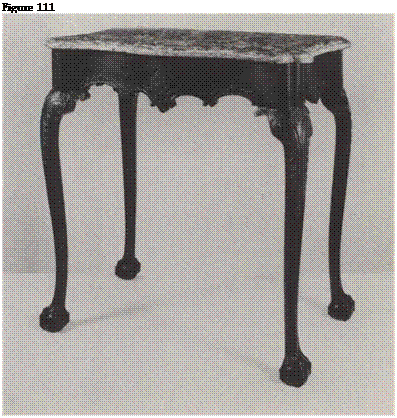 |
This table must have stood in a small dining room or entry hall. Its weight is relieved by its serpentine curved top and frame, indented corners, and a shaped skirt that is emphasized by carved C-scrolls, leaves, and cabochon. Fig. Ill: mahogany, yellow pine, walnut; 1760-75; W 33" (83.8 cm); originally owned by the Smith family, Germantown, Penn.; acc. no. G56.30.2.
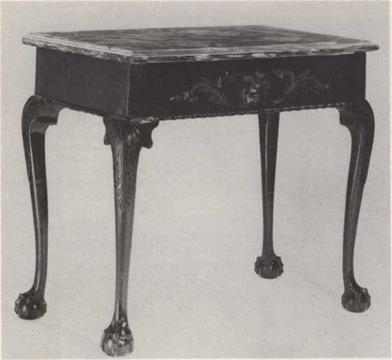 |
Figure 112. Side Table. Benjamin Franklin’s Philadelphia home had a pair of tables "to suit" a sideboard table, and "marble side boards" were included in the 1784 sale of the furnishings of William Hamilton of Bush Hill.61 The small size of Figure 112 and its mate might indicate that they were made to match a larger slab table. The rectangular shape of its frame, emphasized by applied gadrooning in the skirt and balanced shell and leaf streamers carved on the front rail, was certainly intended to give an impression of massive size. Fig. 112: mahogany; 1765-80; W 36" (91.4 cm); one of a pair; acc. no. G59.3402.
Figure 113. China, or Tea, Table. This table should be compared with a New York tray-top china or tea table (Fig. 35).
A carved shell is centered on a gadrooned skirt on all sides, indicating that this table was to stand away from a wall. Deep, lush, flower and leaf carving decorates each leg. Philadelphia price lists of 1772 and 1786 refer to this form as a square tea table and indicate that a similar example would cost 6 pounds or more. In 1776, the Philadelphia town house of William Logan contained in the front parlor a mahogany "Tea Table" and a mahogany "China Table."62 Fig. 113: mahogany, white cedar; 1765-80; W 31V (80.6 cm); acc. no. G60.1060.
|
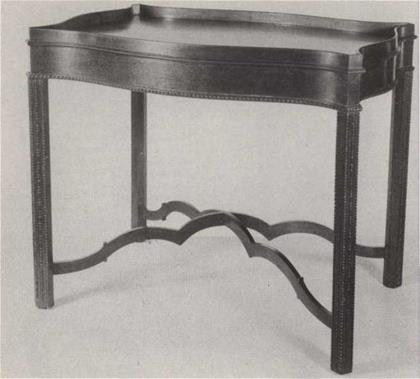 |
Figure 114. China, or Tea, Table.
Thomas Chippendale conceived tables that would hold "a Set of China" or that "may be used as Tea-Tables." The serpentine top, rails, and saltire stretcher of Figure 114 were adapted from Plates XXXIIII (1754 ed.)or LI (1762 ed.)of the Director. Mahogany china tables with stretchers and "commode" or serpentine-shaped tops are recorded in 1772 and 1786 price lists in Philadelphia. Such tables cost more than 7 pounds 10 shillings without rope-carved edges and bead-and – reel carved moldings on the legs (as shown here). Fig. 114: mahogany; 176585; W 32 W (81.9 cm); асе. no. C61.820.
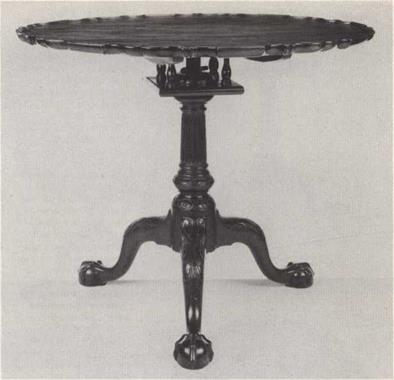
Figure 115. Tea Table. A cabinetmaker, carver, and turner collaborated to produce this tea table. Horrior noted that cabinetmakers could buy components ready to assemble for tripod-base tables, or send specifications for a particular pillar and top to a woodturner.63 At least one other table like this has survived.64 Elongated baluster or vase-shaped turnings on the birdcage, a flattened ball on the shaft, and typical claw-and-ball feet help to identify this as a Philadelphia table. "A large round mahogany tea table” was included in the inventory of John Cadwalader’s house.65 Fig. 115: mahogany; 1765-80; H 28Ve" (71.4 cm), Diam 34 W (87.3 cm); асе. no. C60.1061.
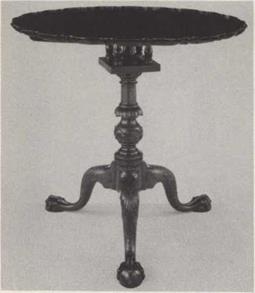
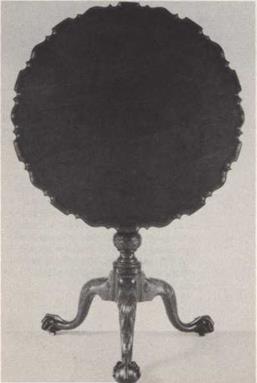 Figure 116. Tea Table. Judging from the number of tables that have survived, card playing and tea drinking were the most popular diversions in colonial America. The shaped top illustrated here (Figs. 116a, 117-118) is the usual form of piecrust edge for circular tea tables and stands. Variation in the decoration of such tables was achieved on this example by extending leaf carving onto the sides of each leg in scroll form; carving the top surface of each leg at its juncture with the shaft; and carving a canopy of gadrooning over the flattened ball of the shaft. Leaf, C-scroll, and ruffle carving (in the "modern" taste on the latter) contrasts with a classical guilloche carved just below it. Fig.
Figure 116. Tea Table. Judging from the number of tables that have survived, card playing and tea drinking were the most popular diversions in colonial America. The shaped top illustrated here (Figs. 116a, 117-118) is the usual form of piecrust edge for circular tea tables and stands. Variation in the decoration of such tables was achieved on this example by extending leaf carving onto the sides of each leg in scroll form; carving the top surface of each leg at its juncture with the shaft; and carving a canopy of gadrooning over the flattened ball of the shaft. Leaf, C-scroll, and ruffle carving (in the "modern" taste on the latter) contrasts with a classical guilloche carved just below it. Fig.
116: mahogany; 1765-80; H 29" (73.7 cm), Diam 29V (75.6 cm); acc. no.
C58.2215.
Figure 116a

![]()
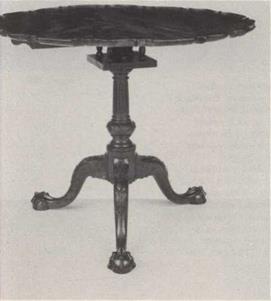 Figures 117 and 118. Tea
Figures 117 and 118. Tea
Tables. As with Figure 116, carving extends from the top of the legs of Figure 117 to their sides. Exposed surfaces at the base of the shaft are carved with classical bellflower husks echoing carved decoration of each leg. The flattened ball is undecorated, but the top hides a fluted pillar and a birdcage. A C-scroll cartouche and leaves are carved in a more conventional manner on the legs of Figure 118. Rope carving decorates the upper band of the shaft base, and leaf carving undulates about the surface of the typical flattened ball. Fig. 117: mahogany; 1760-75; H 29%” (75.2 cm), Diam 33" (83.8 cm); acc. no. G59.3405. Fig. 118: mahogany; 1760-75; H 28Vs" (73.3 cm), Diam 36%" (93 cm); acc. no. G59.3404.
![]()
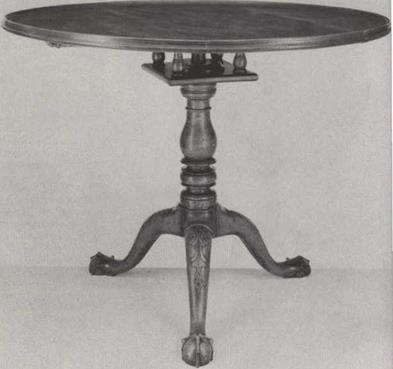 |
Figure 119. Tea Table. Maple furniture is often given a country origin without hesitation. But maple was advertised for furniture in Philadelphia.66 This table exhibits other clues to help assign it a rural provenance. Carving is rare on country furniture, and where found doesn ‘t equal the skills of urban artisans. Here, legs are decorated with stiff, precise leaves that terminate in a design similar to the hands of a clock. The block from which the ball feet were carved is visible. The dished top edge is shaped to give a stepped effect and the spool, ring, disc, and vase-shaped turned shaft are evidence of a skilled, but rural, artisan. It may have been made in the counties of Delaware, Chester, or Lancaster, Penn. Fig. 119: maple; 1760-75; H 28W (72.4 cm), Diam 363A" (93.4 cm); acc. no. G58.1460.
![]()
 Figure 120. Tall Clock. Relative to other furniture forms, few clocks were produced in colonial America throughout the 18th century. They represented the collaboration of clockmakers for the movements; cabinetmakers or joiners for cases to house the movements; carvers, who ornamented the cases; and merchant importers for the dials, movements, and took. In 1772, a mahogany case with scroll pediment head, column corners, fret, dentils, shield, roses, and bases cost 12 pounds without glazing and without extra carving. Many features of Philadelphia case furniture are in evidence here, including carved flame – and-urn finials; broken arch pediment with carved rosettes; floral, leaf, and pierced shell carving in high relief;
Figure 120. Tall Clock. Relative to other furniture forms, few clocks were produced in colonial America throughout the 18th century. They represented the collaboration of clockmakers for the movements; cabinetmakers or joiners for cases to house the movements; carvers, who ornamented the cases; and merchant importers for the dials, movements, and took. In 1772, a mahogany case with scroll pediment head, column corners, fret, dentils, shield, roses, and bases cost 12 pounds without glazing and without extra carving. Many features of Philadelphia case furniture are in evidence here, including carved flame – and-urn finials; broken arch pediment with carved rosettes; floral, leaf, and pierced shell carving in high relief;
C – and S-scroll blind fret carving; indented, fluted quarter columns; and ogee-bracket feet. Fig. 120: mahogany; 1765-75; H 102V (261.4 cm); eight – day movement made or assembled by Edward Duffield (1720-1801); acc. no. G52.247.
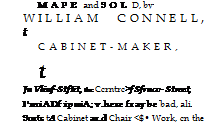
![]()
 Figure 121
Figure 121
Figure 121. Tall Clock. It is tempting to correlate the conservative style and plain appearance of Figure 121 with Quaker taste in Philadelphia. Thomas Wagstaffe (1724-1802), the English Quaker craftsman who made its movement, engaged in extensive trade with importers in all of the colonies.67 His clocks appear in cases ranging from plain to very elaborate. More likely, the customer who ordered this case from William Connell (Fig. 121a) wished to save money. By choosing walnut and eliminating fretwork carving and dentils—but still ordering indented, fluted quarter columns at the corners; Carved rosettes, and a scroll pediment head; a raised panel or shield in the base section; and ogee-bracket feet—a customer would pay 8 pounds, thus effecting a saving of 4 pounds. Philadelphia cabinetmakers such as Henry Clifton, John Folwell, and others are known to have produced clockcases,68 Few bear labels. It is especially frustrating that little is known about William Connell (w. 1760-75) or his work. Fig. 121: walnut, white cedar, yellow pine; 1760-75; H105" (266.6 cm); eight-day movement; acc. no. G60.1149.

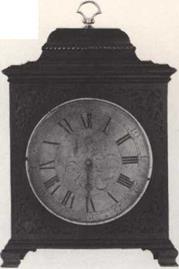
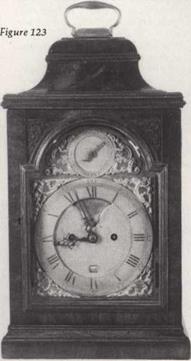 Figures 122 and 123. Bracket, or Shelf, Clocks. Cases for bracket, or shelf, clocks were also conservative in basic form or shape. Figure 122 has gadrooned molding on its sarcophagus-shaped top; pierced fret-carved spandrels of C – and S-scrolls; hearts and flames; and ogee- bracket feet. All tell a viewer that the owner was conversant with fashionable elements of the new style.
Figures 122 and 123. Bracket, or Shelf, Clocks. Cases for bracket, or shelf, clocks were also conservative in basic form or shape. Figure 122 has gadrooned molding on its sarcophagus-shaped top; pierced fret-carved spandrels of C – and S-scrolls; hearts and flames; and ogee- bracket feet. All tell a viewer that the owner was conversant with fashionable elements of the new style.
The owner of Figure 123 would pay only for leaf and C-scroll blind fret spandrels. By eliminating ogee-bracket feet and other niceties, a considerable sum was saved. Thomas Chippendale refers to these forms as "Table Clock Cases" in his Director (1762 ed.). Their name implies that they were displayed on a table rather than on a bracket or shelf. Few American examples have survived. Fig. 122: mahogany, mahogany veneer on yellow pine, tulip; 1771; H 1Ш" (28.8 cm); watch movement by John Morgan, London (w. 1692-1715); assembled by Burrows Dowdney, Philadelphia (advertised 176871); асе. no. C61.516. Fig. 123: mahogany; 1765 — 90; H 18’k" (46 cm); eight-day movement by Robert or Thomas Best, London (w. 1765-94); assembled by Edward Duffield, Philadelphia (17201801); асе. no. C58.1929.
 Figure 124
Figure 124
Figure 124. Tall Clock. Philadelphia cabinetwork influenced woodworkers in Delaware, Maryland, New Jersey, and rural Pennsylvania. This clockcase was probably made in or near Reading, Berks County, Penn. Chamfered corners on the base section; indented, fluted quarter columns on the pendulum case; a carved shell above a shaped door in the same section (Fig. 124a); and scroll pediment with carved rosettes are hallmarks of Philadelphia clockcases. While it is conceivable that this case was made in Philadelphia and shipped to Reading, the execution of its carving speaks of a rural provenance. The design and carving of this clock – case are not closely related to Lancaster County examples.69 Its bracket feet are more like the designs of George Hepplewhite and Thomas Sheraton, and its enameled dial is a type imported in large quantities following the end of the American Revolution. Fig. 124: walnut, white pine; 17851800; H 100%" (255.8 cm); eight-day movement; assembled and made by Daniel Rose (1749-1827), Reading, Penn.; acc. no. 65.2.
|
Figure 124a
|
|
|
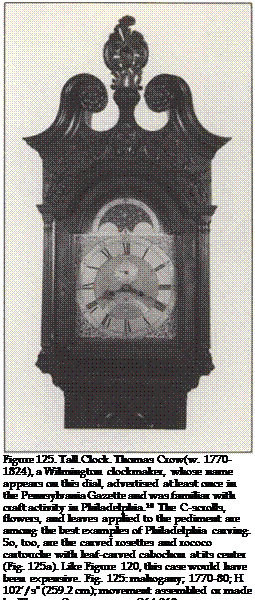
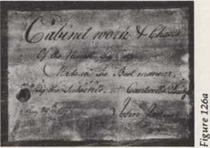 |
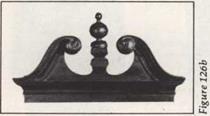 |
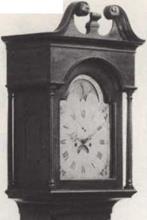 |

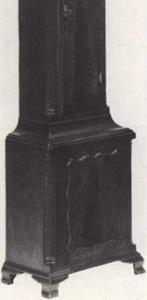 Figure 126. Tall Clock. Another labeled clockcase (Fig. 126a) gives evidence of the influence of Philadelphia’s version of the Chippendale style outside its environs and of the retention of that style quite late in the 18th century. Ogee bracket feet, indented fluted quarter columns at the corners of the base and pendulum case sections, a cyma-curved raised panel or shield, and scrolled pediment atop a straight cornice (Fig. 126b) are features of Philadelphia clockcases. But from the convenient date supplied by the Cantwell’s Bridge casemaker, it is clear that it was made in 1795. More than 20 years earlier, John Janvier, Sr. (17491801) had advertised that he was from Philadelphia when he set up shop in Elkton, Md. Fig. 126: walnut, white cedar, tulip; 1795; H 94і/*" (240.6 cm); finial not original; acc. no. 64.175.
Figure 126. Tall Clock. Another labeled clockcase (Fig. 126a) gives evidence of the influence of Philadelphia’s version of the Chippendale style outside its environs and of the retention of that style quite late in the 18th century. Ogee bracket feet, indented fluted quarter columns at the corners of the base and pendulum case sections, a cyma-curved raised panel or shield, and scrolled pediment atop a straight cornice (Fig. 126b) are features of Philadelphia clockcases. But from the convenient date supplied by the Cantwell’s Bridge casemaker, it is clear that it was made in 1795. More than 20 years earlier, John Janvier, Sr. (17491801) had advertised that he was from Philadelphia when he set up shop in Elkton, Md. Fig. 126: walnut, white cedar, tulip; 1795; H 94і/*" (240.6 cm); finial not original; acc. no. 64.175.
|
Figure 127. Armchair. The clear identification of Southern-made furniture is not always possible (PI. XVI). Maryland was influenced both by furniture and craftsmen from Philadelphia. ",Bold appearance, exaggerated ears, heavy carving, broader splat, lacking delicacy of proportion," are phrases used to describe furniture that bears Philadelphia features but is different in overall appearance. Secondary woods are the same in both Maryland and Pennsylvania, so it is best to indicate that chairs like this were made in either place. Fig. 127: mahogany, tulip; 1765-80; H 4 I’Ve" (105.1 cm); acc. no. G57.504. |
|
Figure 128. Armchair. Philadelphia influence is discernible, but the heavy C-scrolled arm supports are not like the reverse cabriole leg seen on most Philadelphia armchairs. The pierced strapwork splat is also much wider than usual. The ruffle on the crest rail, leaf at the center of the splat, shell on the front seat rail, and leaves on the front legs are all evidence ofaskilled Maryland (probably Baltimore) carver. Fig. 128: mahogany, arborvitae; 1755-65; H 39W (100.6 cm); acc. no. G57.667. |
|
Figure 129. Armchair. A side chair shown in Hammond-Harwood House ‘&ure is identical in its splat design, carving, stiles, and molded front Marlborough legs.”’ The serpentine-shaped front seat rail, concave arm supports, reverse S-curved armrests, and curving stiles give a visual impression of movement and restlessness that would have pleased any exponent of the "modern" taste. Fig. 129: mahogany, yellow pine; 1765-80; H 39’M" (99.3 cm); асе. no. C51.24. |
|
Figure 130. Easy Chair. At least 3 Southern easy chairs have survived * that share the vertically scrolled arm supports and armrests; broad surfaced knees on the front legs; tapered rear legs ending in a pad or platform; and New York – or Massachusetts-type claw-and-talon grasping a ball exhibited by this chair.72 Figure 50, a Philadelphia chair, has similar features. Undecorated surfaces in this period indicate conscious choice rather than lack of sophistication or skill. In 1771, Peter Manigault wrote to his London agent to send furniture and silver "the plainer the better so that they are fashionable."73 Fig. 130: walnut; 1750-70; H 44" (111.8 cm); tradition of ownership by the Lewis family of Virginia; acc. no. 51.72.1. |
|
Figure 131. Side Chair. This chair shares the wide splat, ogee molded * front Marlborough legs, and exaggerated ears often ascribed to Maryland chairs (Figs. 127-29; PI. XV). The design of the splat owes more to Robert Manwaring’s The Cabinet and Chairmaker’s Real Friend and Companion (London, 1765) than it does to Chippendale’s Director. Such designs were frequently adapted by Massachusetts craftsmen, and it may be significant that the lower portion of the rear legs is raked backward, a practice followed by Bay State chairmakers. As early as 174 7, an importer in Annapolis offered maple desks and chairs from New England to his customers.14 Fig. 131: mahogany; 1765-80; H 374z" (95.2 cm); acc. no. 51.64.7. |
Figure 132. Chest of Drawers. In recent years, much fine furniture has been identified as the product of cabinetmakers working in the Shenandoah Valley of Virginia and Piedmont areas of North Carolina and Georgia.
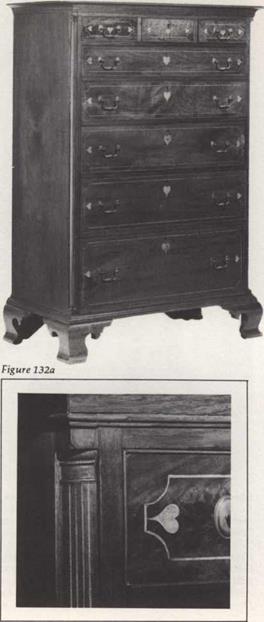 Figure 132—with strings of inlay on its drawer fronts forming a panel with incurved corners; inlaid heart-shaped medallions; string inlay instead of fluting running the length of indented quarter columns at the corners (Fig. 132a); bold, large, ogee-bracket feet; and a vertical bead finishing the rear edges of its sides—resembles case furniture made in the Catawba area of the North Carolina Piedmont.’’5 Heart-shaped motifs were not confined to the Pennsylvania Germans: they are found on furniture made by Anglo-American craftsmen who worked in Connecticut, New York, and Pennsylvania (Fig. 122).
Figure 132—with strings of inlay on its drawer fronts forming a panel with incurved corners; inlaid heart-shaped medallions; string inlay instead of fluting running the length of indented quarter columns at the corners (Fig. 132a); bold, large, ogee-bracket feet; and a vertical bead finishing the rear edges of its sides—resembles case furniture made in the Catawba area of the North Carolina Piedmont.’’5 Heart-shaped motifs were not confined to the Pennsylvania Germans: they are found on furniture made by Anglo-American craftsmen who worked in Connecticut, New York, and Pennsylvania (Fig. 122).
Fig. 132: walnut, white oak, yellow pine;
1780-1810; H 65Vh"
(165.3 cm); acc. no. G67.1724.
Figure 133. Candlestand. This stand was purchased in Craven County, N. C., and some believe it is of Southern origin, probably Charleston, S. C.76 The stance of its tripod-base legs seem Philadelphia – inspired, but its oversized claw feet; fully delineated ball; and baluster, or vase-shaped, pillar just under the birdcage section are unrelated to Northern-made stands and its carving doesn’t have the lush quality associated with Philadelphia. Fig. 133: mahogany; 1765-80; H 2T4s" (69.7 cm), Diam 25Ъ" (65.1 cm); acc. no. G52.259.
|
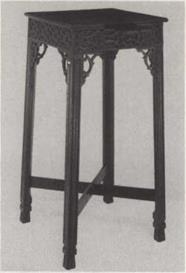 Figures 134 and 135. Kettle, or Urn, Stand and China, or Tea, Table. The unusual foot on this kettle stand (Fig. 134) appears on a Southern marble-top side table with a blind-fret carved frieze on its frame.11 Figure 135 is described in Philadelphia price lists as a china table "three feet long, Bases [Marlborough] feet and Brackets with fret Frame." Such a mahogany table cost 8 pounds in Philadelphia, but Thomas Elfe charged 20 pounds for a "China frett tea table" in Charleston, S. C.1B Inflated currency probably accounts for the disparity in price. Fig. 134: mahogany, tulip; 1765-80; H 25V (64.5 cm); probably Charleston, S. C.; асе. no. C52.63. Fig. 135: mahogany, white pine, tulip; 1765-80; H 25W (65.7 cm); probably Charleston, S. C.; асе. no. C52.141.
Figures 134 and 135. Kettle, or Urn, Stand and China, or Tea, Table. The unusual foot on this kettle stand (Fig. 134) appears on a Southern marble-top side table with a blind-fret carved frieze on its frame.11 Figure 135 is described in Philadelphia price lists as a china table "three feet long, Bases [Marlborough] feet and Brackets with fret Frame." Such a mahogany table cost 8 pounds in Philadelphia, but Thomas Elfe charged 20 pounds for a "China frett tea table" in Charleston, S. C.1B Inflated currency probably accounts for the disparity in price. Fig. 134: mahogany, tulip; 1765-80; H 25V (64.5 cm); probably Charleston, S. C.; асе. no. C52.63. Fig. 135: mahogany, white pine, tulip; 1765-80; H 25W (65.7 cm); probably Charleston, S. C.; асе. no. C52.141.
|

